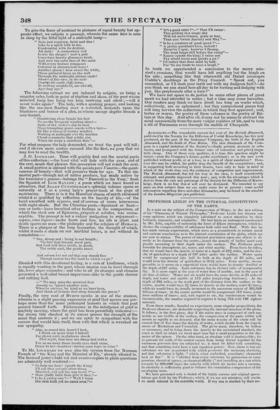PROFESSOR LESLIE ON THE INTERNAL CONSTITUTION OF THE EARTH.
In a note on the subject of the Compression of Water, in the new edition of his "Elements of Natural Philosophy," Professor Leslie has thrown out some opinions which are singularly calculated to arrest attention by their boldness, ingenuity, and originality. He had lately an instrument constructed by Mr. Me, capable of sustaining the force of fifteen atmospheres, which in- dicates the compressibility of substances both solid and fluid. With this be
has made various experiments, which serve as a groundwork to certain novel and curious conclusions as to the internal constitution of the globe, which we are now to notice. The power of internal gravitation upon any object is di- rectly as its distance front the centre—hence the density of bodies must vary greatly according to their depth under the surface. The Professor gives formulm for atmospheric air, water, and white marble. From these he infers, that air would have the density of water at a depth of 331 miles, and the den- sity of quicksilver at a depth of 197 miles under the surface. Water again would be compressed into half its bulk at the depth of 93 miles, and would have the density of quicksilver at 364 miles. Even marble, incom- pressible as it seems on a superficial view, would have its density doubled at the depth of 287 miles. Each substance has its distinct ratio of compressibi- lity. It is more rapid in the case of water than of marble, and in the case of air them of either. Water and air would have the same density at 35 miles of depth, and water and marble at 173 miles (neglecting fractions). At the depth of 396 miles, or the tenth part of the distance from the surface to the centre, marble would have 31 times its density at the surface, water 4Ti times, while air would have its density increased to the enormous extent of 101,960 billions of times. At the centre marble would be compressed 119 times, water three millions of times; arid, with regard to air, the 'condensation would be inconceivable, the number required to express it being 764 with 166 ciphers annexed.
From these results, founded on experiment, some singular propositions, the
Professor observes, are deducible respecting the internal structure of the globe. It follows, in the first place, that if the entire mass is composed of such ma- terials as are visible at the surface, the compression of the parts within will mount so rapidly as we descend, that the mean density of the whole will far exceed that of five times the density of water, which results from the experi- ments of Maskelyne and Cavendish. The globe must, therefore, be hollow or cavernous, and to bring down the density to the ascertained standard, the crust or shell on which we tread must bear but a small proportion to the dia- meter of the sphere. On the other hand, an absolute void is inadmissible; for to prevent the walls of the central cavern from being forced together by the enormous pressure they are subjected to, it must be filled with something, and that something must have a vast repulsive power. Now, there is but One substance we are aquainted with which possesses the necessary elasticity, and that substance is light, " which, when embodied, constitutes elemental heat or fire." It is "elicited from every substance by percussion or com- pression, electrical agency, or chemical affinity ;" and travelling at a rate which exceeds by 800,000 times the velocity with which air rushes into a vacuum, its elasticity is sufficiently great to balance the cumulative compression of the enveloping mass.
We have presented only a sketch of the highly curious and original specu- lations put forth by the Professor; which, if we are not mistaken, will excite
no small interest in the scientific world, If any one is startled by their no-
velty and boldness, we advise him to peruse the Note with its formulw, and follow carefully the Professor's chain of reasoning, before he pronounces upon the subject. In the mean time, we shall only observe, that it is interesting to find new light breaking in upon us as to the structure of the globe from so many different sources. Laplace was led to the same conclusions respecting the earth's density from studying some astronomical phenomena (the nutation, we think, of the terrestrial axis), which Dr. Maskelyne arrived at from swing- ing a pendulum at ScheinIlion; and here we find our distinguished townsman deducing from the mechanical laws of compression, doctrines very similar to those which M. Cordier was conducted to by observing the heat of mines and springs. We say similar, for they are not identical, but the two are capable of combination. Conner, finding a source of heat in the body of the earth, concluded that it went on increasing to the centre, and that the whole was filled with fused matter ; not aware that the operation of a principle, the ex- istence of which was unknown to him, would in such a case have led to results inconsistent with the ascertained density of ths earth. Referring those who wish for more precise information to the work itself, which either has ap- peared or is just about to appear, we shall close this article with the following striking paragraph which concludes the Professor's Note:—
"We are thus led, by a close train of induction, to the most important and striking conclusion. The great central concavity is not that dark and dreary abyss which the fancy of poets had pictured. On the contrary, this spacious internal vault must contain the purest ethereal essence—light in its most con- centrated state, shining with intense refulgence and overpowering splendour."



















 Previous page
Previous page